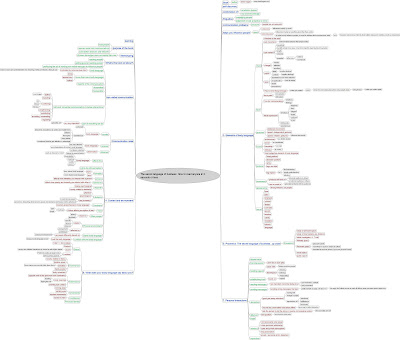Mind mapping is a technique to collect, record and organize ideas. It's a very powerful tool. Now with the availability of several free and commercial software to do mind mapping, it's much easier to put this very effective technique into practice.
Mind mapping is a very simple technique. Central idea is to build around the core. For example, let's say you start reading a book. You glance through the book and record the theme of the book at the center. Then secondary ideas are recorded all around the center and connected by lines which can denote relationship.
Beauty of mind mapping is that it first lets to you collect as many ideas as possible and then lets you organize them as appropriate. 'To get the best idea, first you have to get a lot of ideas' - this is at the heart of brainstorming. Linear way of recording ideas impedes the brain because brain does not think linearly. It builds connections between ideas. When we start recording ideas linearly, we actually impede the free flow of ideas. By starting to mind map, we give the freedom that brain craves for over the artificial order that we want to follow. Once we dump all ideas randomly on a paper and look that random zig zag picture, sometimes great insights come into picture.
I always used to find that despite spending a lot of time reading on variety of subjects I did not get the return back on the time spent. When I had to refer back to something, I had to remember the book on that topic, go back, look through the contents and then refresh my knowledge and understanding. That was a good start but I still wanted better return on investment. So, I started making high level notes in the form of a mind map and I am astonished to say the least about how effective it is in terms of getting the big picture. These day I fire up 'Free mind', an open source free program, on my laptop as I read something making one or two notes about each paragraph I read. It takes little longer but I can always go back to refer to them. That's where the maximum return on investment is.
Since I learnt that liner note taking or jotting down points impedes free flow of ideas, I use mind maps to come up with presentations, long e-mails, plans etc. Once I have a mind map on any topic, I can expand or reduce it to the level I want.
You can read more about mind mapping at - http://en.wikipedia.org/wiki/Mind_map
You can also search on YouTube for some excellent videos on mind mapping. Also, look for excellent books by Tony Buzan. He systematized the art of mind mapping and his books are really good.
You can download 'Free Mind' software from sourceforge.net. It's a great tool.
Below is a mind map of few chapters from the book 'The secret language of business: How to read people....". Just to illustrate that it does not take much time, I read about 80% of the book quickly in probably 4-5 hours over 3-4 sessions. Made the mind map as went along. Beauty was every time I picked up the book, I could scan the mind map for a few seconds and remember very well about the past reading and dive into the next part with complete understanding.
Free mind tool lets you export into variety of formats. You can export into a PDF and share your mind maps with people who may not have free mind.

Powered by Qumana








